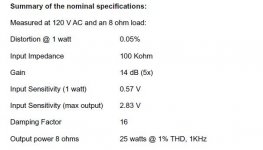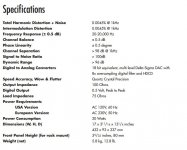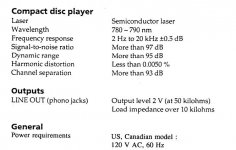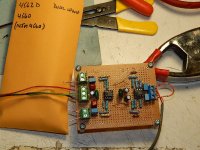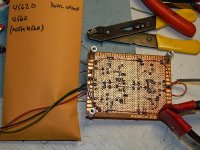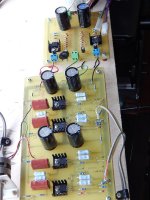like ZM said one has to read up on the designs before making anything. I put several years into lurking around the forum before making anything. Tons of info around. First Watt specs are all listed very clearly:
FIRST WATT PRODUCTS
the gain structure has also been discussed:
http://www.diyaudio.com/forums/diyaudio-com-articles/186018-what-gain-structure.html
and there is a number of preamp designs on the forum (I myself use AlephP, BA-3 FE and Juma's design with bf862).
It all starts with a choice of speaker and the desired volume in a given listening space. everything else follows from there. (this is not to say that i always started from the right end of things either and did not sometimes feel like ; mainly due to a change of direction which is probably a common infliction among DIYers, you know how it goes: act on an impulse, buy parts, think the big picture later).
; mainly due to a change of direction which is probably a common infliction among DIYers, you know how it goes: act on an impulse, buy parts, think the big picture later).
FIRST WATT PRODUCTS
the gain structure has also been discussed:
http://www.diyaudio.com/forums/diyaudio-com-articles/186018-what-gain-structure.html
and there is a number of preamp designs on the forum (I myself use AlephP, BA-3 FE and Juma's design with bf862).
It all starts with a choice of speaker and the desired volume in a given listening space. everything else follows from there. (this is not to say that i always started from the right end of things either and did not sometimes feel like
 ; mainly due to a change of direction which is probably a common infliction among DIYers, you know how it goes: act on an impulse, buy parts, think the big picture later).
; mainly due to a change of direction which is probably a common infliction among DIYers, you know how it goes: act on an impulse, buy parts, think the big picture later).
Last edited:
Zen Mod has a really excellent preamp, highly recommended.
Thanks (again).
I had a look, but it's a bit hard to decipher the ZM 'style' . Pumpkin? Shunty? Choky Oly, etc ... do you have a link to a specific design?
...as I said, I tend to like simple things that I can have some expectation of understanding.
I have assembled a couple of projects where I just stuffed components into a purchased board and made connections to power and controls, but I didn't find the build process very satisfying - though the audio results were excellent. (ex. Panda Headphone amp).
That simplicity was what attracted me to the Nelson Pass designs when I first started thinking about a SS amp.
I understand that many people with more advanced knowledge are attracted to the opposite style - especially 'over here' in SS world vs in 'tubeland'.
Tons of info around. First Watt specs are all listed very clearly:
FIRST WATT PRODUCTS
the gain structure has also been discussed:
http://www.diyaudio.com/forums/diyaudio-com-articles/186018-what-gain-structure.html
Thanks.
Yes, there is a lot of info around, but also a lot of (deliberate??) confusion as well.
I have the idea that 'input sensitivity' (in clearly specified units) is important, and that it is not just a matter of overall dB gain.
Obviously, what is 'standard' in one area of the diy audio hobby isn't necessarily so in another. (e.g. tube amps, chip amps, SS (Pass) amps).
All part of the learning process.
BTW, I don't wait a few years before starting a project; I'm probably older than most folks here!
I was just re-reading your first post. You say typical output voltage p-p is around 500 mv. What about your CDP ? Aren't digital sources supposed to max out at 2V rms? Is there anything you can do/ check/ change on the source side without necessarily having to use a preamp?
My experience with F5 and 86 dB speakers is that with 2V rms output compliant devices there is much more gain than needed; not so if for instance I connect an ipod.
My experience with F5 and 86 dB speakers is that with 2V rms output compliant devices there is much more gain than needed; not so if for instance I connect an ipod.
I was just re-reading your first post. You say typical output voltage p-p is around 500 mv. What about your CDP ? Aren't digital sources supposed to max out at 2V rms? Is there anything you can do/ check/ change on the source side without necessarily having to use a preamp?
A few minutes with an oscilloscope and some music CDs gave me that info about average & max p-p levels, but I only used a few music samples, so not very reliable data. However, it certainly was a long way from 2v rms. The CD player is my 'shop' (Sony) CDP, which seems to be working the same way as the others I've used in the shop.
I do think that the average music level is kept much lower than possible 'peak levels' (crescendos, loud dynamics) to avoid clipping and distortion. People complain about excessive 'compression' in recordings a lot.
Is the output from your CDP 2 v rms or 2 v p-p or 2 v 'peak' ? It's not at all clear to me what sort of 'volts' are in the specs. Nelson Pass said (above) that he uses rms volts unless otherwise specified.
I think that CDP's output level is supposed to be the same as the 'standard' from tape decks and tuners?
Is there a standard output level from DACs?
What's the output level from an iPod supposed to be?
Last edited:
What about your CDP ? Aren't digital sources supposed to max out at 2V rms?
OK- I did a bit more reading.
One source:
https://en.wikipedia.org/wiki/Line_level#Nominal_levels
The standard reference voltage for line levels is 1 V RMS, set at 0 dB V.
Consumer audio products have a nominal line level of - 10dBV or 0.316 V RMS equivalent to 0.894 Vp-p
Compare that to the 2.83 V RMS input required to drive the F6 to maximum output. (from the FirstWatt specs)
I use rms volts unless otherwise stated.
Isn't that a difference of 19dB to get the nominal CDP level up to the input required to drive the F6 to maximum output?
Attachments
Last edited:
wikipedia is interesting place
certainly less trusty than writings on Tom Sawyer's wood fence
just take a look at few commercial CD players , and see what's usual output voltage figure
however , to cut a story short , avoiding further mixing of apples and oranges - every proper/regular power amp of this world will do better if you have preceding gain stage, with gain of 6-9db
if room/speaker combo permits , you can go well with just buffer (0db) in front , but mentioned solution will cover all cases
speaking of that - tube amps with under-volt input sensitivity and Gainclones aren't in any way in group of regular power amps
certainly less trusty than writings on Tom Sawyer's wood fence
just take a look at few commercial CD players , and see what's usual output voltage figure
however , to cut a story short , avoiding further mixing of apples and oranges - every proper/regular power amp of this world will do better if you have preceding gain stage, with gain of 6-9db
if room/speaker combo permits , you can go well with just buffer (0db) in front , but mentioned solution will cover all cases
speaking of that - tube amps with under-volt input sensitivity and Gainclones aren't in any way in group of regular power amps
so , verdict , regarding thread title , clearly is
Something is wrong with my ideas and builds

An explanation followed......
just take a look at few commercial CD players , and see what's usual output voltage figure
sure...please explain the meaning of these..pics attached.
Thanks.
Attachments
speaking of that - tube amps with under-volt input sensitivity and Gainclones aren't in any way in group of regular power amps
Glad you cleared that up....
sure...please explain the meaning of these..pics attached.
Thanks.
it's clearly written at second pic - 2V
and serious manufacturers are always stating voltage figures in Vrms
so , if something is fishy when 2V is stated, they simply lied , trying to stay in common industry bracket
however , to cut a story short , avoiding further mixing of apples and oranges - every proper/regular power amp of this world will do better if you have preceding gain stage, with gain of 6-9db
I agree- I'm off to put together a preamp.
I agree- I'm off to put together a preamp.
http://www.diyaudio.com/forums/pass-labs/293169-whats-wrong-kiss-boy.html
Thanks for the link to that discussion.
I had a look and 'read' a lot of it.
For me, it was like 'falling down the Rabbit Hole' in Alice in Wonderland....
A strange world where nothing made sense or followed any logical pattern!
Strictly for the smarter, more electronically competent folks, that.....(like most of the ZenMod world)...it's nice to see that there's stuff here at diyaudio to amuse us, no matter whether our abilities are strictly 'beginner' (like me) or advanced.
I agree- I'm off to put together a preamp.
I put together a Rod Elliott IC-based preamp (his Project#88) in a few hours with parts off the shelf here, using perfboard and the info on his website.
High Quality Audio Preamp
9dB gain (once I put in the volume and balance controls). It's around 12dB right now without attenuation between the 2 stages.
I had a bunch of used LM4562 ICs from tearing apart a broken mixer board some years ago..but they are quite cheap anyway.
The perfboard fits right in with the rustic style of my F6 (plain fiberglass board, wired P2P).
I'd recommend buying Rod's PCB for the project- he deserves the support for publishing so much good info on his website. (I ordered Rod's board last night once I had my perfboard version working..)
Next: wire up the other channel of the F6.
And, figure out the best PS for the preamp- it's running on the bench supply now. Either some 7815/7915 regulators off the F6 supply, or a separate PS that I can perhaps find in my 'junk pile' from old CD/DVD/receivers.
Attachments
VictoriaGuy,
What was wrong with BOSOZ with the F6? Changing to a different preamp will change things somewhat but you issue with gain is solved by bosoz...but you said you didn't like it.
I don't recall saying I didn't like BOSOZ; perhaps I did, in a fit of exasperation.
I'm actually 'saving' the BOSOZ for possible use with an Aleph J which might use the balanced capability of BOSOZ better. (??)
Also, whatever choice I made for a volume control (and perish the thought
Low resistance value ganged audio pots aren't available, and I'm not really interested in stepped attenuators (lack of fine control), particularly diy building of stepped attenuators.
The Elliott preamp puts the controls between the two gain stages, which seems to have some advantages to my untutored mind.
And the Elliott #88 is cheap and effective, and a lot smaller than the BOSOZ. I could probably make the BOSOZ more compact with a different board layout or by using P2P and perfboard.
Paying in increments of $100 CAD for small bags of 'unobtanium' jfets which may be the 'wrong grade' or 'not properly matched' gets vexing, quickly.
But, I shouldn't be here in the Pass sub-forum if I think that way!!
Attachments
- Status
- This old topic is closed. If you want to reopen this topic, contact a moderator using the "Report Post" button.
- Home
- Amplifiers
- Pass Labs
- Pass Amps- JUst insensitive or is something wrong with my ideas and builds?
